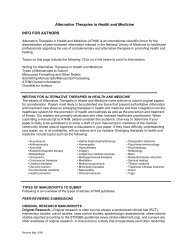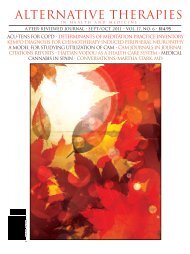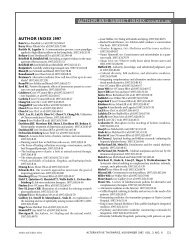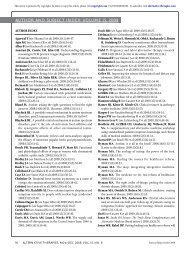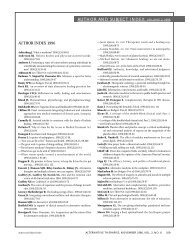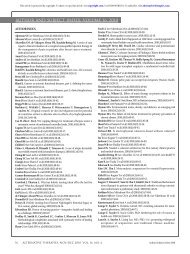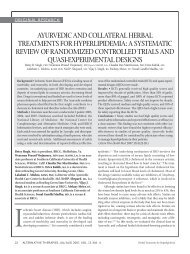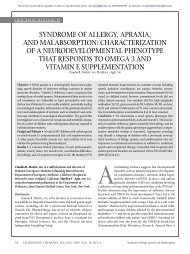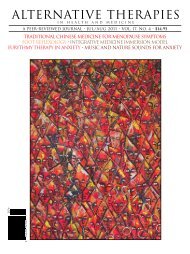Alternative Therapies In Health And Medicine
Alternative Therapies In Health And Medicine
Alternative Therapies In Health And Medicine
You also want an ePaper? Increase the reach of your titles
YUMPU automatically turns print PDFs into web optimized ePapers that Google loves.
20 drops, three times daily; dil Hypericum Auro culta 1%, 20 drops<br />
twice daily.<br />
Eurythmy therapy observations, exercises, and<br />
follow-up<br />
The patient was asked to perform exploratory EYT exercises,<br />
and the therapist’s initial observations were as follows: The stream<br />
of movement appeared as fastened around head and shoulders,<br />
with drawn-up shoulders, stiffness in back, neck and breast region,<br />
and with pale complexion. The limb movements were tense, generally<br />
dexterous but over-formed and stretched out in the periphery;<br />
fingers were tensely pressed together; foot movements were hasty,<br />
overexerted, jerky, and carried out with too much pressure; footsteps<br />
were short. Breathing appeared shallow. <strong>In</strong> contrast to healthy<br />
people, there was very little ability to flow in her movement and to<br />
undulate elastically between polar eurythmic movement qualities<br />
such as fast and slow, tensed and relaxed, upward and downward,<br />
light and heavy, center-oriented and periphery-oriented, gymnastically<br />
dexterous and emotionally expressive. The pattern of observed<br />
movement anomalies was discerned as a “breathed-in-upwards syndrome”<br />
(Sidebar) and was conceived as an integrated bodyfunctional<br />
expression of both a state of anxiety and a rhythmic<br />
system disturbance. Accordingly, this EYT-specific diagnosis<br />
matched the interpretation of the physician.<br />
To treat the syndrome, specific exercises were selected. For their<br />
descriptions, therapeutic goals, and schedule of introduction, see the<br />
Table. A 20-minute video presentation of the exercises can be seen at<br />
http://www.ifaemm.de/F5a_publi.htm. Several of these exercises<br />
(Foot E, IAÅ + Spatial form, B + deep knee bends, Rhythm Yes-No, R,<br />
Low pendulum M) were specifically chosen because of their antagonistic<br />
relation to the breathed-in-upwards syndrome; the syndrome itself<br />
would specifically impede correct conduct of just these very exercises<br />
in all their eurythmic complexity. Conversely, it was expected that continuous<br />
endeavor to correctly conduct these exercises would clear away<br />
the specific impediments and hereby allow rebalance of the organism’s<br />
three-fold constitution (see the sidebar), thus achieving recovery.<br />
Other exercises were introduced in order to warm up the periphery of<br />
the body (Love E) or to relax tension. For details, see the Table.<br />
Follow-up<br />
The patient came to the first therapy sessions in a serious and<br />
tense mood and conducted the movements gymnastically, effective<br />
though overalert. Towards the end of the treatment period, her<br />
mood became happier; she was then able to express herself emotionally<br />
in the EYT sessions and did so in joy and lightness. The<br />
patient showed an interest and natural ability for movement in general,<br />
which helped her to quickly connect herself with each exercise<br />
in physical, emotional, and personal respect.<br />
During the 8-week treatment period, the anxiety symptoms<br />
of the patient substantially improved according to her own as well<br />
as her physician’s and her counselor’s accounts and according to<br />
the therapist’s observations. After half the period (4 weeks), the<br />
patient had fewer anxiety and bodily symptoms, felt physically<br />
stronger, and was able to take up part-time employment and<br />
become socially active again.<br />
The improvement of the anxiety syndrome was parallel to<br />
changes in those specific movement patterns that had been regarded<br />
as causally related to the anxiety syndrome (see section about<br />
anthroposophic medicine diagnosis and the sidebar) and were specifically<br />
aimed at by the EYT exercises. These observations are<br />
described below (For exercise descriptions, see the Table.)<br />
First Session<br />
Exploratory exercises: Provisional EYT exercises were introduced<br />
to acquaint the patient with EYT, to enable EYT-specific<br />
observations, and to select exercises (Table).<br />
Second Session (After 1 Week)<br />
IAÅ + spatial form (to regulate the patient’s focus on how her<br />
intentions come to expression): <strong>In</strong> the first session, this exercise had<br />
demonstrated upward tension in the breast region, stiff fingers, and<br />
overformed gestures in the periphery; the whole exercise had been<br />
performed too quickly and was outward orientated. Now, when<br />
moving backwards in the context of this exercise, the patient<br />
showed the first signs of “coming to herself ”; the steps had also<br />
become somewhat more peaceful and slower.<br />
B + deep knee bends (to loosen tension around the head,<br />
ground the patient): During the first session, the back had been stiff<br />
and straight. Now the patient achieved a soft bending in her back,<br />
which had an immediate therapeutic effect: She relaxed somewhat<br />
in her neck and shoulders and connected more with her feet (ie, she<br />
became grounded).<br />
Third Session (1 Week Later)<br />
The R exercise was introduced (to relax the breast and back<br />
region and so work through the rhythmical system).<br />
Fourth Session (1 Week Later)<br />
The patient had been bedridden with a cold and was unable to<br />
practice more than once. She arrived at the session with menstrual<br />
pain and a headache.<br />
R exercise: Previously, the patient had been able to manage<br />
this exercise only with a straight back. <strong>In</strong> the present session, she<br />
could roll more flexibly through the breast region, which was associated<br />
with an immediate effect: She became warm, breathed more<br />
freely, and her cheeks became rosy.<br />
B + deep knee bends: This movement became, unlike in the previous<br />
sessions, inwardly expressive. Again, there was the relaxing and<br />
grounding effect as in previous sessions but somewhat stronger.<br />
IAÅ + spatial form: Moving backwards was conducted with<br />
peaceful steps and an inwardly expressive A gesture; the Å gesture<br />
still remained stiffly held.<br />
Low pendulum M: (to relax muscle tonus, strengthen “breathing-out-downwards”):<br />
After introduction, an immediate relaxation<br />
in the breast region and “breathing out” could be observed.<br />
Fifth Session (1 Week Later)<br />
The patient had begun work again at 50%. <strong>In</strong> addition to the<br />
58 ALTERNATIVE THERAPIES, jul/aug 2011, VOL. 17, NO. 4 Eurythmy Therapy in Anxiety



